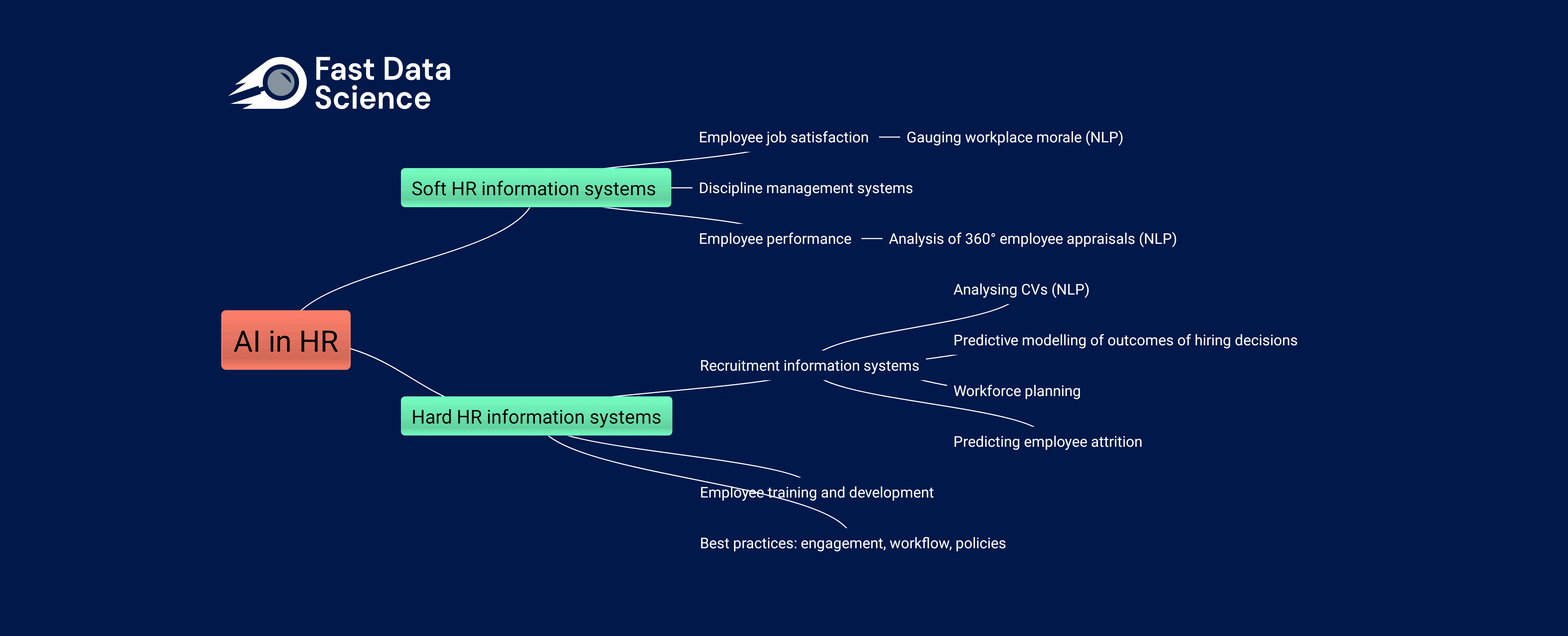
The world of work is rapidly changing, both due to traditional data science practices being adopted by more organisations, and due to the increasing popularity of generative AI tools such as ChatGPT, and Google’s BARD among non-technical workers. AI has the potential to boost global GDP by 7%, with the loss of millions of jobs, although it will also create new jobs for the displaced workers, according to a 2023 editorial by Goldman Sachs.
AI is also poised to revolutionise traditional HR processes, redefine the role of HR professionals, and enhance data-driven decision-making.

One possibility is that AI will disrupt and supercharge HR functions, redefining roles where AI would mean that human resources professionals become competent in AI and use it to improve their productivity. I consider it unlikely that AI will replace HR professionals. AI is good at crunching data, but human beings are still needed for tasks requiring empathy or strategy, such as strategic workforce planning.
Some companies are already using AI for their HR processes, such as recruitment and employee well-being. Accenture uses an AI-powered tool to avoid unconscious bias in job descriptions and its interview process, and Adidas has been using predictive modelling for workforce planning.
Without needing to go to cutting-edge technologies such as generative AI, traditional machine learning models can also predict factors such as workforce attrition. In 2021, Fast Data Science undertook a consulting engagement for the NHS, and we found that there were a number of factors that could be used to identify an employee’s likelihood of leaving the NHS altogether. Based on data in the NHS HR and payroll systems, we were able to train a machine learning model which could both predict employee attrition on an individual level and identify key factors behind it, which could be used to advise hiring and retention practices.
We have used similar predictive models in our case studies to predict customer churn, or to predict young people’s outcomes in the education system in Scotland, or for scoring high school students’ risk of dropping out.
On a lower level, AI could be used to help draft employee emails, suggest questions for interviews, and employment objectives. However, any AI is only as good as the data it’s trained on.
For example, if you were to ask a generative AI image model to produce a photo of a CEO, they are more likely to show you an image of a white male.


Natural language processing
Above: the first two images that I got from an AI image generator. The input prompt was the string “CEO”.
Human resources have already been using IT to facilitate their operations for some time. IT systems in HR can be termed HRIS (Human resources information systems).
Traditional uses of HRIS include workforce planning, management of employee performance and satisfaction, salary, bonuses and benefits. All of these areas currently involve automated systems and IT in large organisations, but the increasing uptake of AI is likely to impact some of these fields in particular.
Natural language processing is likely to have an impact on HRIS. HR operations generate a large amount of unstructured text data and NLP can be very useful for analysing these documents. For example, if a large number of employees mention a particular topic in their exit interviews, an NLP trend detection model could pick up on this and alert the team in charge of employee retention initiatives.
In one consulting engagement, we had a large number of job seekers’ CVs from a job board, along with additional information about the desired salary bracket and industry that each job seeker intended to work in. From this data, we were able to train a predictive model that could predict salary bands from CVs and job postings and also allocate job seekers to industries.
A common use of HRIS within medium to large organisations is the applicant tracking system (ATS), which HR managers use to monitor and administer the journey of a job application from first contact through to the hire. ATS’s are a prime candidate for AI due to the large amount of structured and unstructured data that accumulates in them. It doesn’t take a huge leap of imagination to envision a triaging system for recruiters that can use text analysis to identify which CVs should be passed on for human review.
However, any automatic processing of CVs or other free text coming from outside the organisation could become a slippery slope. Jobseekers tend to dislike keyword matching algorithms, and the perceived use of these algorithms can lead to job seekers gaming the algorithm by keyword stuffing: they will throw in keywords that they believe will improve their chances of getting past an automated CV triaging system. Hopefully, as natural language processing algorithms used in human resources move beyond simple keyword-based metrics, it will become harder to understand the system and game the algorithm.
A lack of transparency means an increased risk of bias in algorithm-based scoring in HR. There have been a number of unpopular uses of numerical metrics to gauge employee performance, particularly with key performance indicators or KPIs. KPIs are often strongly disliked by the workforce, especially if implemented badly. An example of an absence-oriented KPI would be the Bradford Factor formula for measuring worker absenteeism, where days missed by an employee are divided into spells of consecutive days and then multiplied to achieve an overall score that is intended to represent the disruption to the business caused by the employee’s absences.
Bradford Factor = Number of unrelated absence periods² x Days absent
Employees with chronic illnesses such as autoimmune diseases, and employees undergoing long-term treatment such as chemotherapy, complain that this kind of metric penalises them unfairly. This illustrates why human intervention is so important in HR and why simple scoring metrics such as the APGAR score cannot have exact equivalents in HR.
Furthermore, it has been argued that the Bradford Factor creates a perverse incentive, where employees with transmissible illnesses are encouraged to come to work despite feeling unwell (presenteeism), resulting in the disease spreading to others. The British trade union Unison described the Bradford Factor as “a blunt instrument that takes little account of what is happening to an individual‟s health”.
AI has the potential to significantly impact HR in several ways:
| Area of HR | Examples of AI in HR |
|---|---|
| Automation of repetitive tasks | AI can automate many time-consuming tasks, such as screening resumes, or scheduling interviews. This will free up HR professionals to focus on more strategic and value-added activities. |
| Data-driven decision-making | AI can analyse large volumes of employee data to identify patterns and trends that would otherwise be invisible. These insights can then be used to inform HR strategies and improve organisational outcomes. |
| Talent management | AI can help organisations identify and develop high-potential employees. It can also be used to predict employee attrition and retention rates. |
| Employee engagement | NLP techniques such as sentiment analysis can be used to analyse employee feedback. |
| General staff management | Language models and chatbots can handle employee onboarding, recruitment, training, and leave requests |
Businesses may encounter a number of polarising responses when AI is introduced in the workplace. People are excited by new technology, but they are also nervous about what it could mean for them. In particular, they may be afraid of being replaced by AI. AI projects may encounter pushback from employees.
For this reason, it’s important for management to do a sanity check before introducing AI, or even mooting its introduction in an organisation. For example, you should always ask yourself if your AI is really needed. Just because it’s a cutting-edge and exciting tool, it may not deliver value. Secondly, work out the impact of your AI on your company’s bottom line, on clients, on staff, and on any external stakeholders. Thirdly, after the AI is introduced, you should monitor its performance, that is, its accuracy and any concrete impact it is having on your operations.
While AI has the potential to revolutionise HR, it is important to consider the following challenges and considerations:
Job displacement: AI could automate some HR tasks, which could lead to job displacement in certain areas.
Impact on employee morale: The introduction of AI could raise concerns among employees about job security and the potential for AI to make decisions about their careers.
Data privacy and ethics: It is important to implement robust data governance practices to protect employee privacy and ensure that AI is used ethically. When training an AI on sensitive data, we need to check that we are complying with data protection regulations such as GDPR, as well as any relevant AI-specific legislation, or even any legislation that is likely to materialise in the future.
Companies need to think about introducing AI policies and informing staff about what is appropriate and inappropriate use of AI.
Organisations can implement AI responsibly in HR by following these guidelines:
Assess the need for AI: Before implementing AI, ensure that it genuinely addresses a specific business challenge or improves an existing process.
Evaluate the impact on employees: Consider how AI will affect employees’ roles, responsibilities, and job satisfaction. Communicate openly and transparently with employees about the introduction of AI, addressing any concerns and providing opportunities for reskilling or upskilling.
Ensure data privacy and ethics: Implement robust data governance practices to protect employee privacy and ensure that AI is used ethically. Avoid bias in AI algorithms and ensure that AI decisions are fair, transparent, and explainable.
Evaluate the performance of the AI algorithm: Even generative language models can be validated - see my earlier blog post for a list of tools to evaluate generative language models.
Monitor and adapt: Continuously monitor the performance of AI systems and make adjustments as needed. Be prepared to adapt AI strategies as business needs and technologies evolve.
AI has the potential to transform HR into a more efficient, data-driven, and employee-centric function of a business. However, it is crucial to implement AI in the business responsibly and ethically, addressing employee concerns and ensuring that AI complements, rather than replaces, human expertise. AI systems, or any kind of automated system in the HR process, can lead to perception of bias, increase employee dissatisfaction and workforce attrition, or induce cynicism or a tendency to game the system in employees and job seekers. By striking the right balance, organisations can harness the power of AI to enhance their HR operations and create a more productive and engaged workforce.
Chris Stokel-Walker, AI: how HR can ask (and answer) the right questions, People Management, 2023.
Unison, Sickness Absence: the Bradford Factor, 2014.
Votto et al, Artificial Intelligence in Tactical Human Resource Management: A Systematic Literature Review, International Journal of Information Management Data Insights, 2021.
Looking for experts in Natural Language Processing? Post your job openings with us and find your ideal candidate today!
Post a Job
Thomas Wood presents the Clinical Trial Risk Tool before the November meeting of the Clinical AI Interest Group at Alan Turing Institute The Clinical AI Interest group is a community of health professionals from a broad range of backgrounds with an interest in Clinical AI, organised by the Alan Turing Institute.

Fast Data Science will appear at Ireland’s Expert Witness Conference on 20 May 2026 in Dublin On 20 May 2026, La Touche Training is running the Expert Witness Conference 2026, at the Radisson Blu Hotel, Golden Lane, Dublin 8, Ireland. This is a full-day event combining practical workshops and interactive sessions, aimed at expert witnesses and legal professionals who want to enhance their expertise. The agenda covers critical topics like recent developments in case law, guidance on report writing, and techniques for handling cross-examination.

Guest post by Alex Nikic In the past few years, Generative AI technology has advanced rapidly, and businesses are increasingly adopting it for a variety of tasks. While GenAI excels at tasks such as document summarisation, question answering, and content generation, it lacks the ability to provide reliable forecasts for future events. GenAI models are not designed for forecasting, and along with the tendancy to hallucinate information, the output of these models should not be trusted when planning key business decisions. For more details, a previous article on our blog explores in-depth the trade-offs of GenAI vs Traditional Machine Learning approaches.
What we can do for you